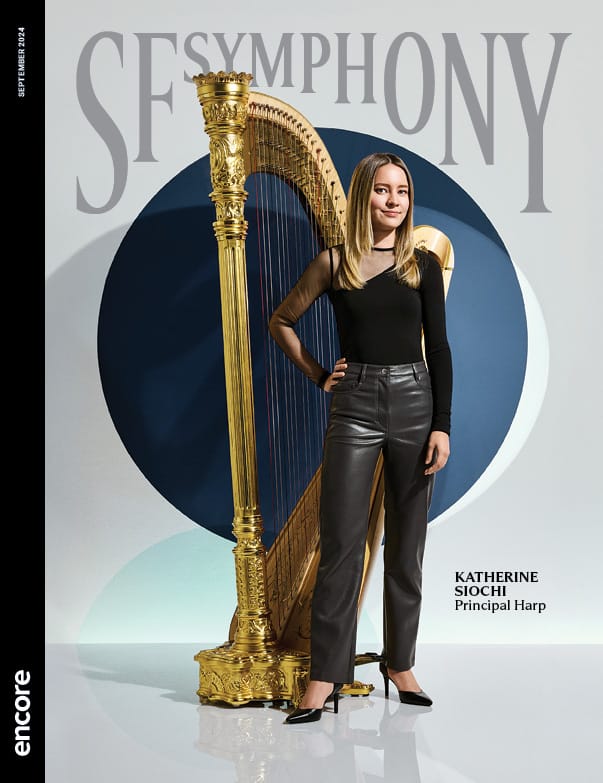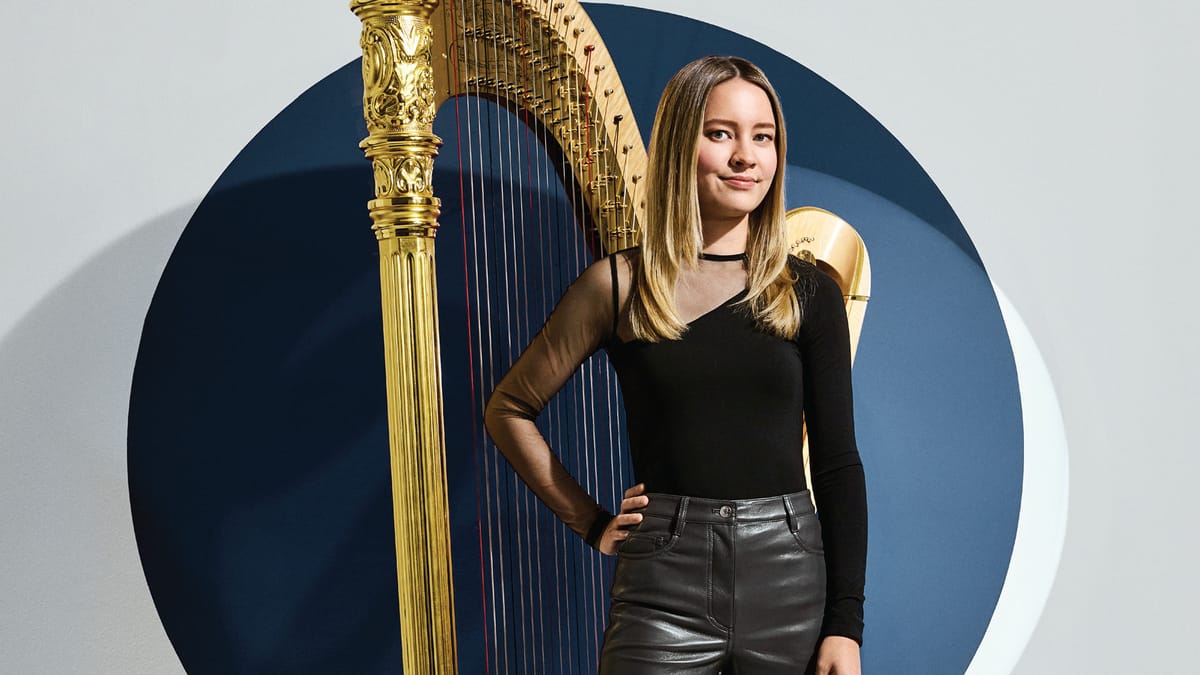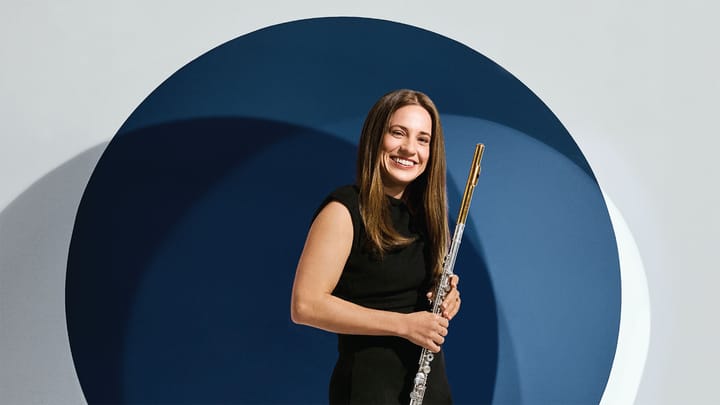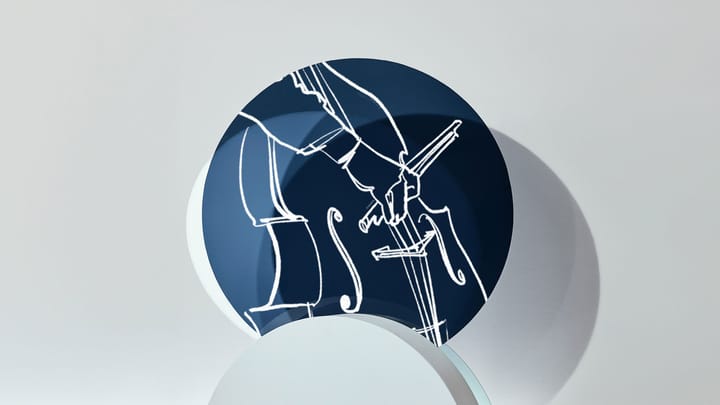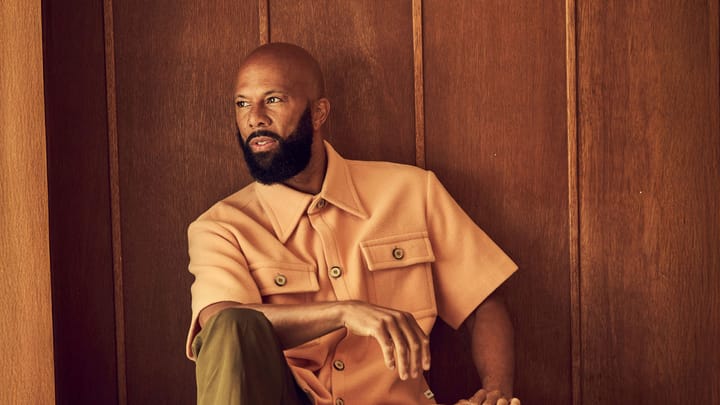September concerts and features
In This Program
- Welcome
- Feature: Creative Connection
- News & Notes
- Community Connections: Bringing Music to All San Francisco
- Meet the Musicians: Katherine Siochi
- Print Edition
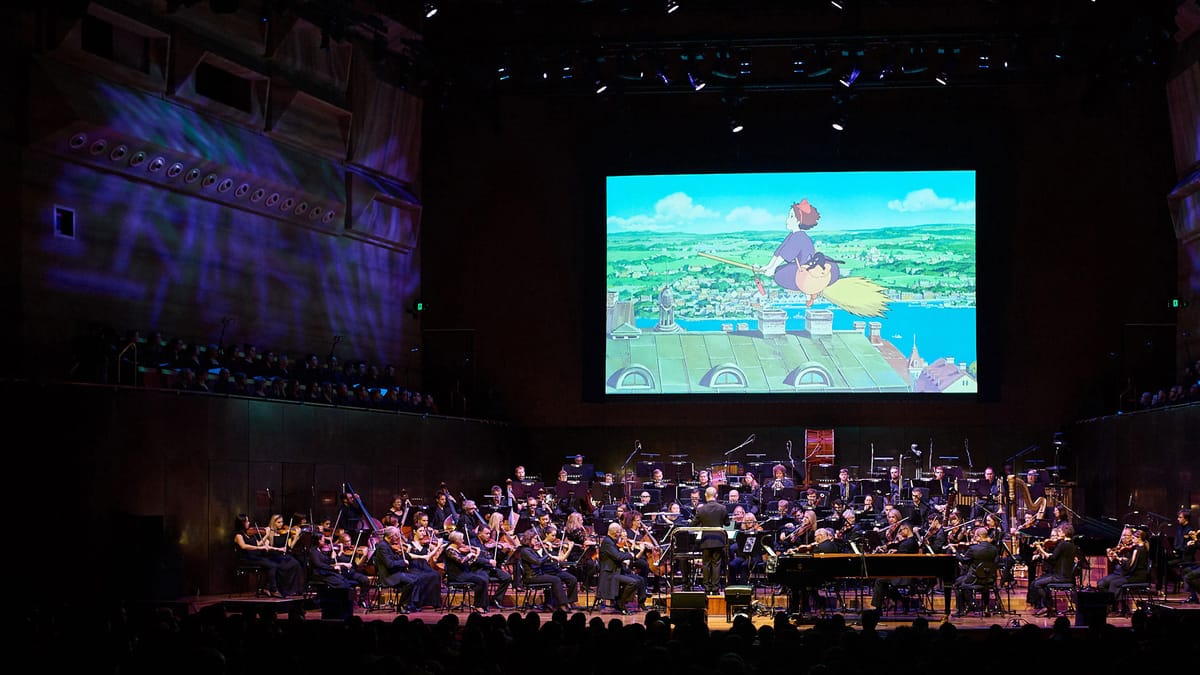
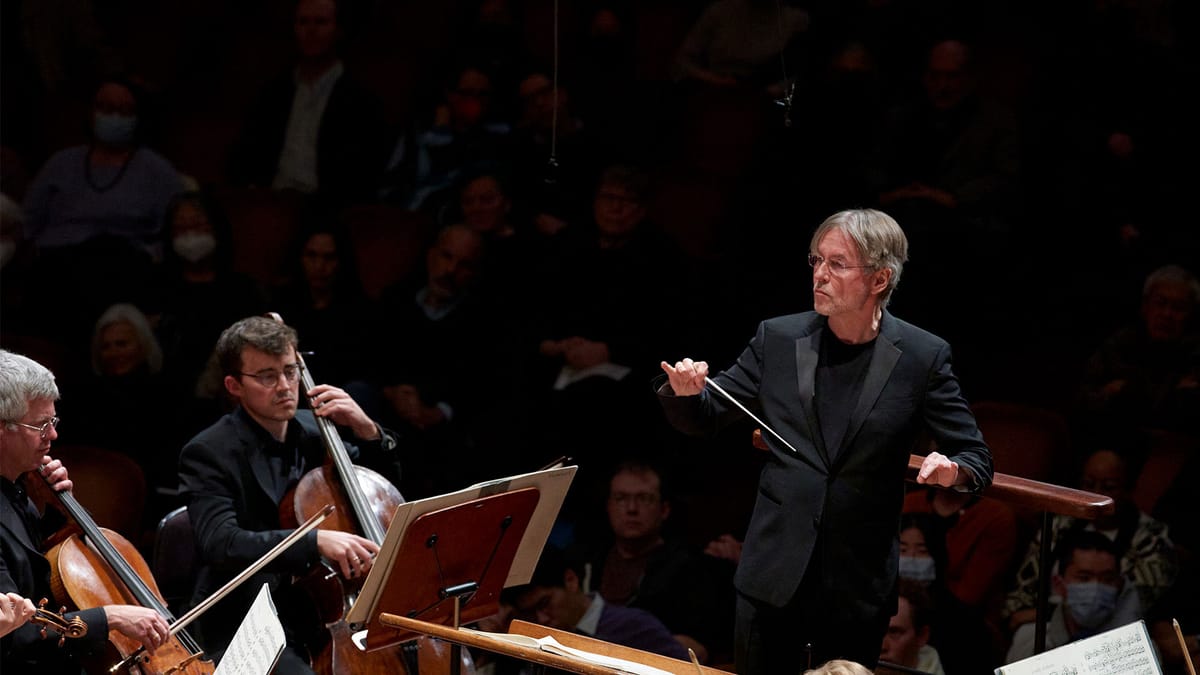
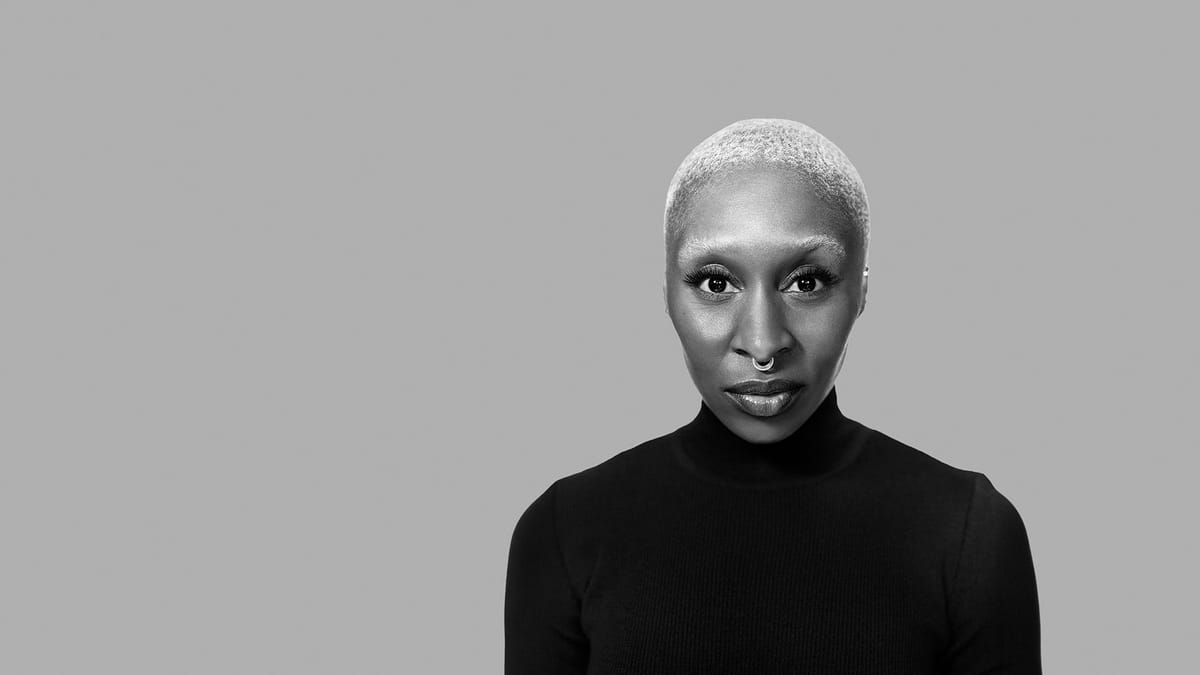
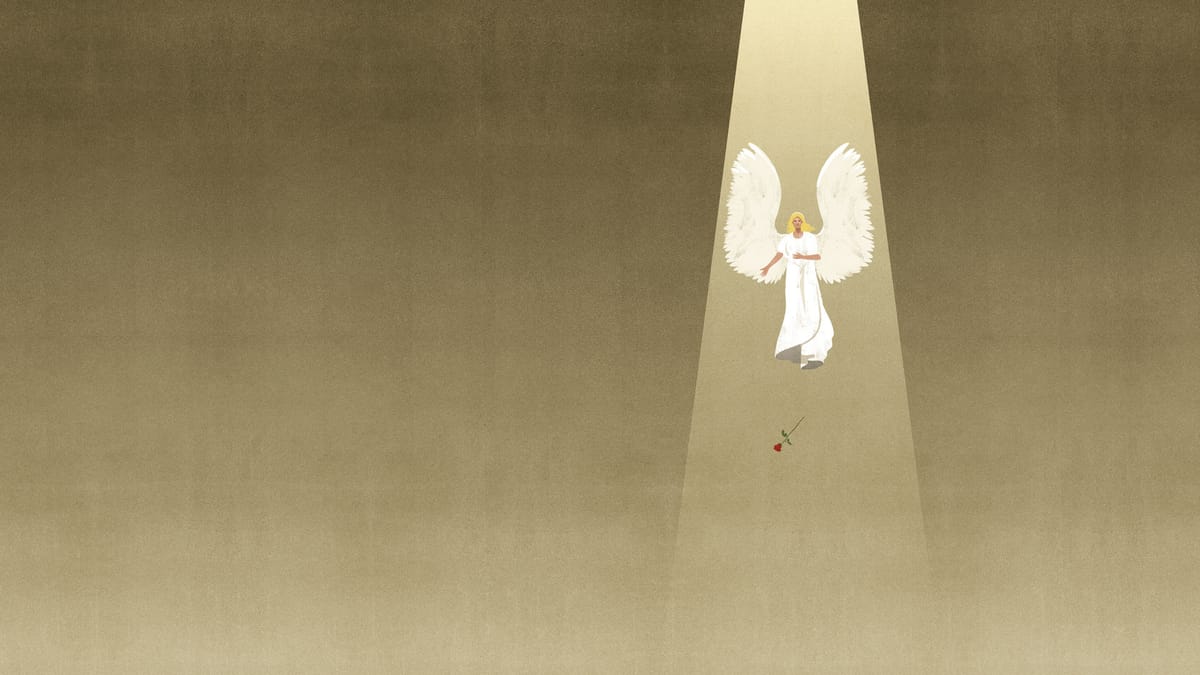
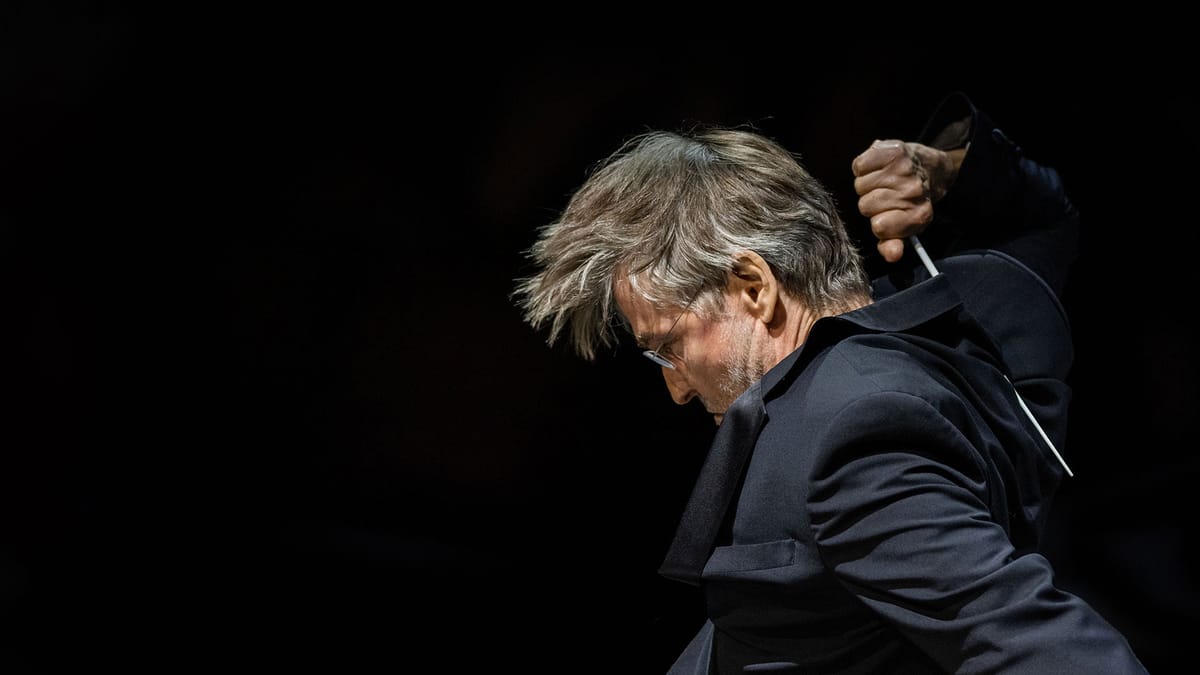
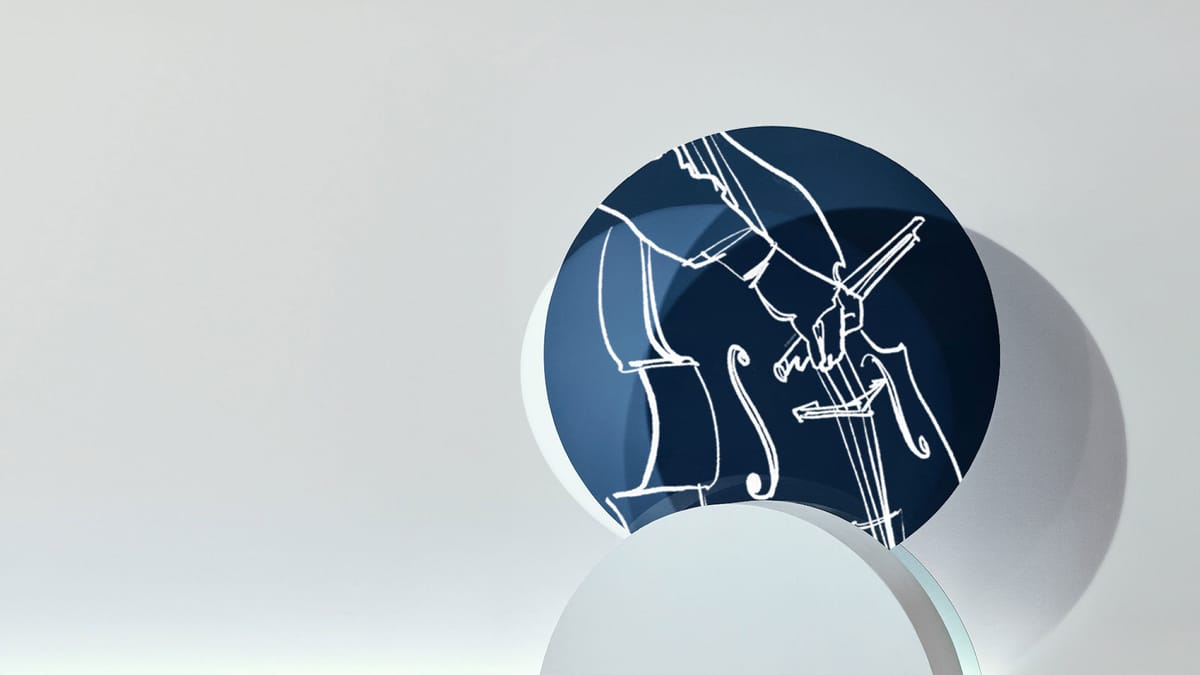
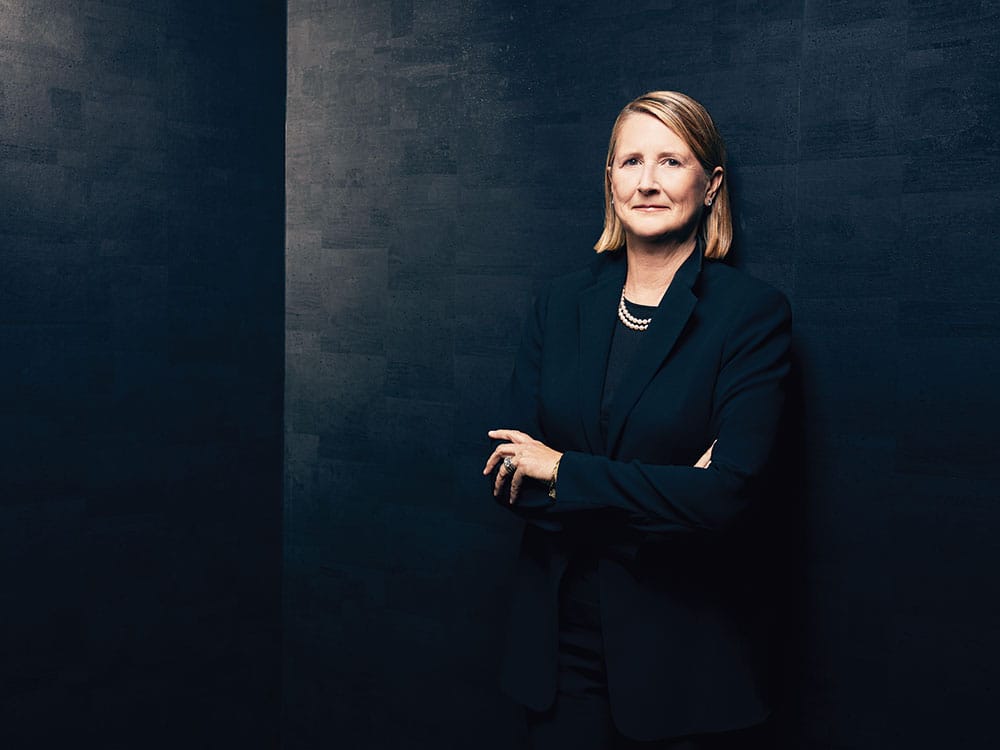
Welcome
There is something magical that happens when 2,500 people gather at Davies Symphony Hall for a San Francisco Symphony concert. Each night, a new community emerges, united by the thrill of experiencing live music together.
In a San Francisco Symphony season, there is something for everyone. That’s why you’ll hear a Mozart symphony one week and a blockbuster film with orchestra like Top Gun: Maverick the next. An intimate chamber concert curated and performed by our Symphony musicians alongside a thrilling choral work like Verdi’s Requiem, brought to life by the SF Symphony Chorus. Or an adventurous SoundBox program next to a concert of Schubert and Brahms. Over the coming months, you’ll hear all these concerts and so much more.
Our audience is equally inspiring in its variety. At any given Symphony concert, you’ll discover longtime Symphony patrons who support the orchestra because they find something here they can’t get anywhere else. There are film fans eager to experience their favorite movies in an ear-opening new way with live orchestra and people attending their first Symphony concert through our Community Ticket Program, which distributes tickets to those working in local nonprofits and service organizations. Or perhaps you’ll encounter a group of San Francisco Unified School District elementary school students on their way to an Adventures in Music concert where they’ll experience a live orchestra for the first time.
As we open our 2024–25 season, I encourage you to explore the range of concerts we offer and to get to know the community of music lovers seated around you. Whether you are a longtime supporter or experiencing the Symphony for the first time, you are all here because you care about the San Francisco Symphony. Together, let’s celebrate music’s power to unite and inspire our Bay Area community.
Priscilla B. Geeslin
Chair, San Francisco Symphony
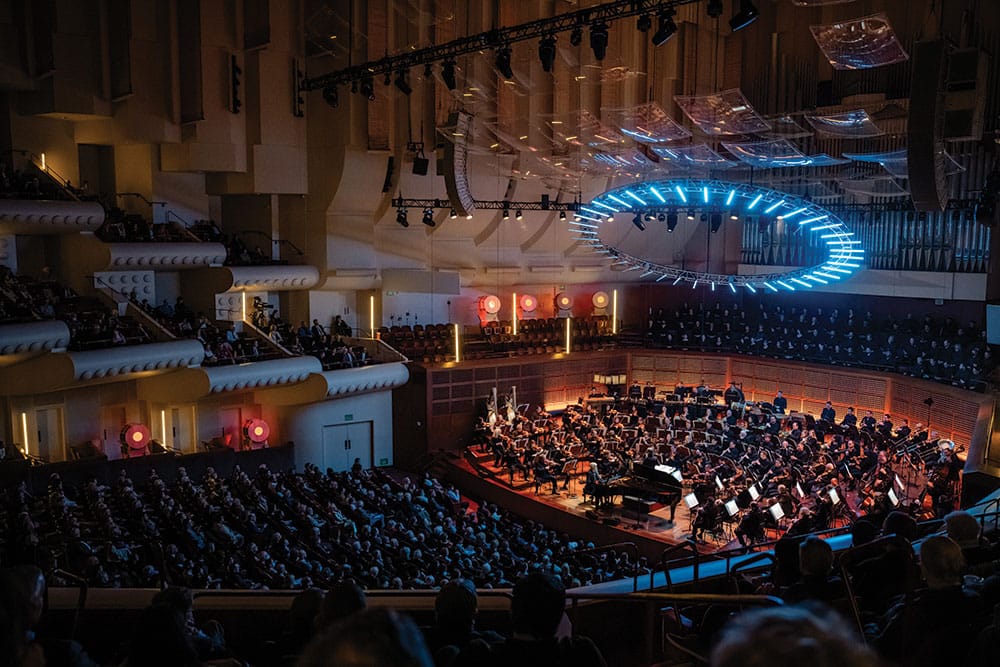
Creative Connection
BY STEVEN ZIEGLER
Priscilla Geeslin and Matthew Spivey on building collaboration, San Francisco’s revival, and why the Symphony is like Muir Woods.
When San Francisco Symphony Board Chair Priscilla Geeslin first started attending Symphony concerts in the 1980s, she encountered a Hayes Valley neighborhood very different than the one that greets concertgoers today. “You could park right outside the hall,” Geeslin, known as Prisca, recalls. “There was one restaurant, Hayes Street Grill, and if you were lucky, you could get in.” Geeslin fondly remembers trips up from the Peninsula, where she and her soon-to-be husband, Keith, worked, for regular outings at the Opera and Symphony. Her involvement with the Symphony grew steadily over the years—first as a volunteer, then as the head of the Volunteer Council, joining the Board of Governors in 1998, and finally becoming Chair in 2020. She’s quick to point out that her experience with the Symphony is not out of the ordinary. “I think it says a lot that people stay here because they’re dedicated, they’re passionate, and they really care. And I think you see it in all aspects of this organization.”
Matthew Spivey, the Symphony’s Chief Executive Officer, also sensed that the San Francisco Symphony was a special place when he first joined the administrative staff nearly a decade ago as Director of Artistic Planning. A clarinetist by training, Spivey first became enchanted by the workings of an orchestra through formative experiences behind-the-scenes at Tanglewood and the Los Angeles Philharmonic. Positions at the Fort Worth Symphony and Baltimore Symphony followed, and when the opportunity arose to dive back into the West Coast’s thriving musical scene—particularly in San Francisco—he couldn’t say no. Spivey has relished working alongside two visionary San Francisco Symphony music directors—first, Michael Tilson Thomas, and later, Esa-Pekka Salonen—cooking up programs for San Francisco’s adventurous audiences. “There is something in the water in San Francisco. Audiences here are innately curious. And I love being around people like that,” Spivey says. “It’s so much more fun to program when you can explore, and you feel like there’s an audience that wants to go there with you.”
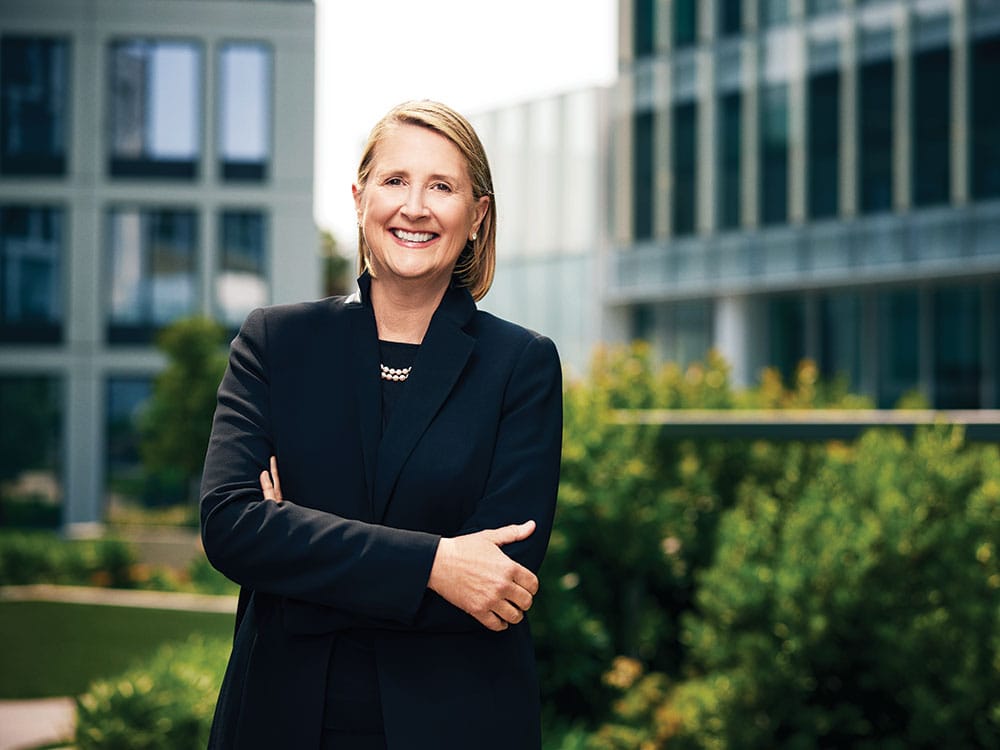
For Geeslin, it was a different type of San Francisco Symphony audience that first made an impression on her. “My daughter went to school in Hayes Valley and one of the things I always loved was walking over to the Adventures in Music concerts. Coming to a concert with younger children, it’s noisy and they’re bouncing up and down in the seats and conducting. It is that moment of pure joy in the hall that you see them engaging. You see that enthusiasm and the brightness it brings to them.” She sees a throughline between Adventures in Music and Music and Mentors—the Symphony’s comprehensive music education programs in partnership with San Francisco Unified School District—Music for Families, and more recent initiatives, like the annual Teen Night concert. “Teen Night took that and expanded it and allowed an older group of students to really be a part and experience the hall in a new way. It’s an exciting way to continue bringing along that next generation of people who want to experience great music and learn about everything that we’re doing here.”
“People want to to engage, they want to be a part of what is going on. And I think we need to tap into that,” Geeslin says.
Spivey highlights recent performances of Scriabin’s Prometheus, The Poem of Fire, developed in collaboration with Cartier, as characteristic of the ways the Symphony can continue to grow and engage new audiences. The multisensory concert—developed by Salonen, pianist Jean-Yves Thibaudet, and Cartier’s in-house perfumer Mathilde Laurent—brought together scent cues, dramatic lighting, and a performance of Scriabin’s work by the San Francisco Symphony and Chorus. “Many of the people who came to that performance had never been to an orchestral concert before,” Spivey says. “And these were individuals who immediately connected with what was happening on stage. There was no barrier, there was no learning curve. You didn’t have to take a course in music appreciation. This was immediately viscerally exciting. And that’s a big part of what we should be trying to accomplish.” Although the conclusion of Salonen’s contract as Music Director signals a transition in artistic leadership, both Spivey and Geeslin believe that future projects with Salonen will continue to explore new ways to connect artists and audiences. “Esa-Pekka’s work has significantly shaped our organization, and I am eager to see what our ongoing collaboration will bring next,” Spivey says.
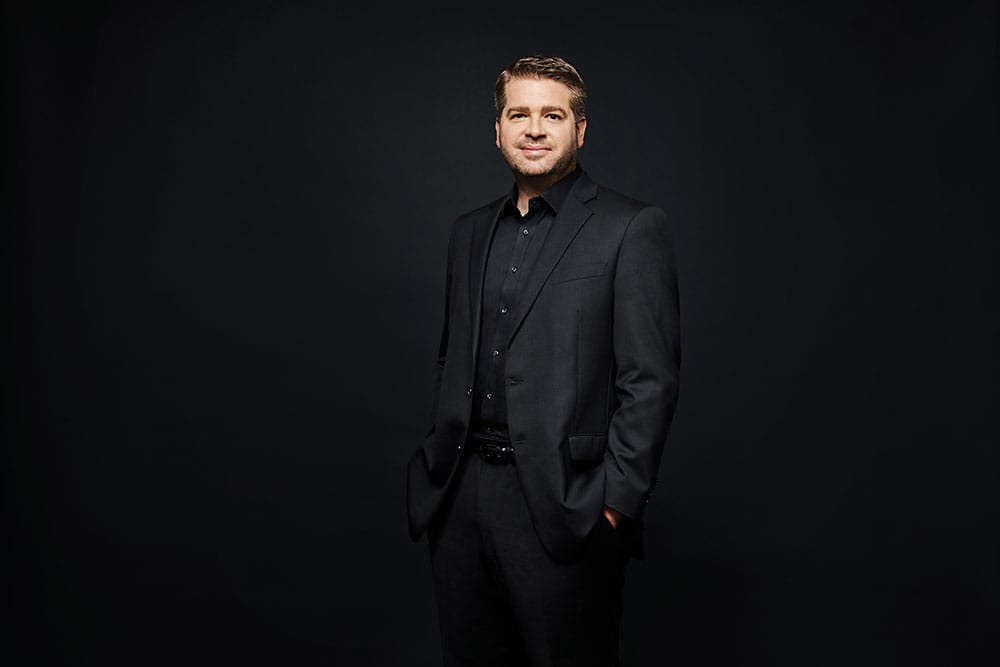
The Prometheus program was especially notable in the way that it brought together a group of artists with different focus areas to create something completely new, something Salonen has prioritized in his time at the Symphony. “I think one of the defining characteristics of orchestral music is its unique ability to be collaborative,” Spivey says. “Orchestras can take many different shapes and forms. They can cross genres. They can work in partnership with almost any instrument or creative discipline: dance, visual art, you name it. And it starts to become especially interesting when you think about how to bring some of those ideas into the concert hall.” Spivey is also eager to explore more partnerships with Bay Area artists, noting “San Francisco is a special place with an extraordinarily eclectic and vibrant arts community. There are so many artists here in our backyard that are doing amazing things. It is both interesting and rewarding to reinforce our artistic identity as being emblematic of San Francisco, of the Bay Area, of California, of the West Coast, and of American music.”
Geeslin views the Symphony’s work in this sphere as part of a larger effort to support the revival of San Francisco following the COVID-19 pandemic. “We have such a richness here in the Civic Center and in San Francisco, with SFJAZZ, the Opera, the Ballet, the Symphony, the Conservatory. San Francisco is coming back, and we are already seeing it. It’s going to take more time, but I think this is really an opportunity.”
Geeslin places the Symphony’s challenges, including a current financial landscape that necessitated expense reductions, within the broader context of the organization’s long-term future. “We have to think about what the Symphony looks like going forward. People want to engage, they want to be a part of what is going on. And I think we need to tap into that. We need to consider what the future audience of the Symphony looks like, what they need, and what they want.”
Spivey picks up this thread, noting “the thing that makes me most excited, the thing I see more than anything else now is an unprecedented level of curiosity and interest. Many more people are interested and those people who enter the hall are walking away even more excited. And I think this is a wonderful opportunity to seize that moment and feed the creative appetite of this next generation of audiences.”
Geeslin says that recent discussions about the Symphony’s future are a positive indication of the community’s dedication to the organization. “We have a passionate city, particularly people who come to the Symphony. They care, they love the Symphony. This is their way of showing how much they care, how much they support everything we’re trying to do.” Spivey elaborates, “The more people who are actively engaged with the organization, the more people who come to concerts and support what the San Francisco Symphony does, the more fuel there is for creativity and the more we can give back to San Francisco and the Bay Area.”
Ultimately, it all comes back to the idea of connection—between the artists on stage, the audience, and the greater community. “I want people to come to a San Francisco Symphony concert because that’s where they feel like they get the nourishment they need,” Spivey says. “I want this to feel like this incredibly special, fertile ground where people come to be replenished and uplifted and to find the most rewarding experiences in life. Just as the redwoods in Marin provide a sacred grove, I want the San Francisco Symphony to be its own musical grove.”
News & Notes
Music Director Esa-Pekka Salonen and the San Francisco Symphony welcome seven new musicians to the Orchestra beginning with the 2024–25 season.
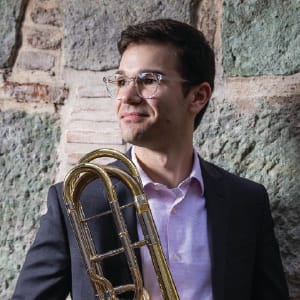
Christopher Bassett joins the San Francisco Symphony as bass trombone. He previously served as bass trombone with the St. Louis Symphony, Jacksonville Symphony, and Santa Fe Opera, and has also performed with the Boston Symphony, Cleveland Orchestra, Cincinnati Symphony, Detroit Symphony, and Indianapolis Symphony. Last season he appeared as a substitute musician with the SF Symphony, including on the March California tour. A native of Oceanside, California, Bassett earned a bachelor of music from New England Conservatory and a master of music from Columbus State University.
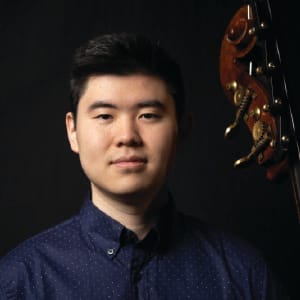
Bowen Ha joins the San Francisco Symphony bass section, holding the Lawrence Metcalf Second Century Chair. Born in Shangai, he is currently a master’s student at the Juilliard School, where he previously earned a bachelor of music. He has appeared as a substitute musician with the New York Philharmonic, Philadelphia Orchestra, and Indianapolis Symphony.
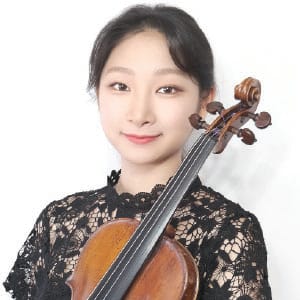
Jeein Kim joins the San Francisco Symphony first violin section, holding the Isaac Stern Chair. She was previously a member of the Korean National Symphony Orchestra and has been a substitute musician with the Chicago Symphony. She studied at Yale School of Music, New England Conservatory, and Yonsei University, and has won top prizes at the Menuhin Competition, Seoul International Music Competition, and Northwest Sinfonietta Youth Competition.
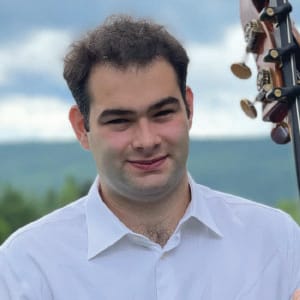
Orion Miller joins the San Francisco Symphony bass section. He previously performed with the London Symphony as a Keston Max Fellow, as a substitute musician with the Houston Symphony, and with the Royal Concertgebouw Orchestra. He also served as principal bass for the National Youth Orchestra of the United States. He earned a bachelor’s degree from the Shepherd School of Music at Rice University and has been a fellow at the Tanglewood Music Center, Music Academy of West, and Aspen Music Festival.
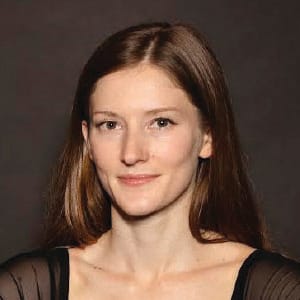
Anne Richardson joins the San Francisco Symphony as Associate Principal Cello, holding the Peter & Jacqueline Hoefer Chair. She was most recently an academy fellow with the Bavarian Radio Symphony and has performed with the Verbier Festival Orchestra, Orchestre de la Suisse Romande, and Pittsburgh Symphony. A native of Louisville, Kentucky, Richardson completed bachelor’s and master’s degrees at the Juilliard School and earned a doctor of musical arts at the University of Michigan. She was named the Kentucky Center’s Gheens Artist in Residence in 2019.
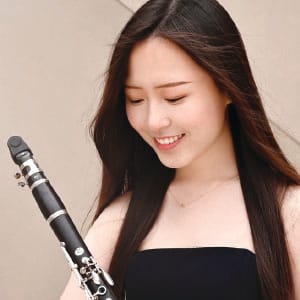
Yuhsin Galaxy Su joins the San Francisco Symphony as Second Clarinet. She recently completed a master’s degree at the Colburn School of Music and before that studied at the Curtis Institute of Music. During her time at Curtis, Su performed Arnold Schoenberg’s Pierrot lunaire in productions at the Kimmel Center, Columbia University, Kennedy Center, and Curtis Field Recital Hall. She has also been a soloist at the Musique et Vin Music Festival and Marlboro Music Festival.
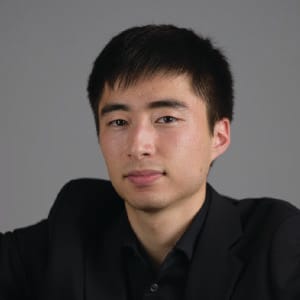
Davis You joins the San Francisco Symphony cello section, holding the Lyman & Carol Casey Second Century Chair. He recently received his bachelor of music from New England Conservatory and regularly appeared as principal cello of the NEC Philharmonia. He was a member of Quartet Luminera, which won the silver medal at the Fischoff National Chamber Music Competition. A Bay Area native, You began his cello studies with Irene Sharp and Jonathan Koh.
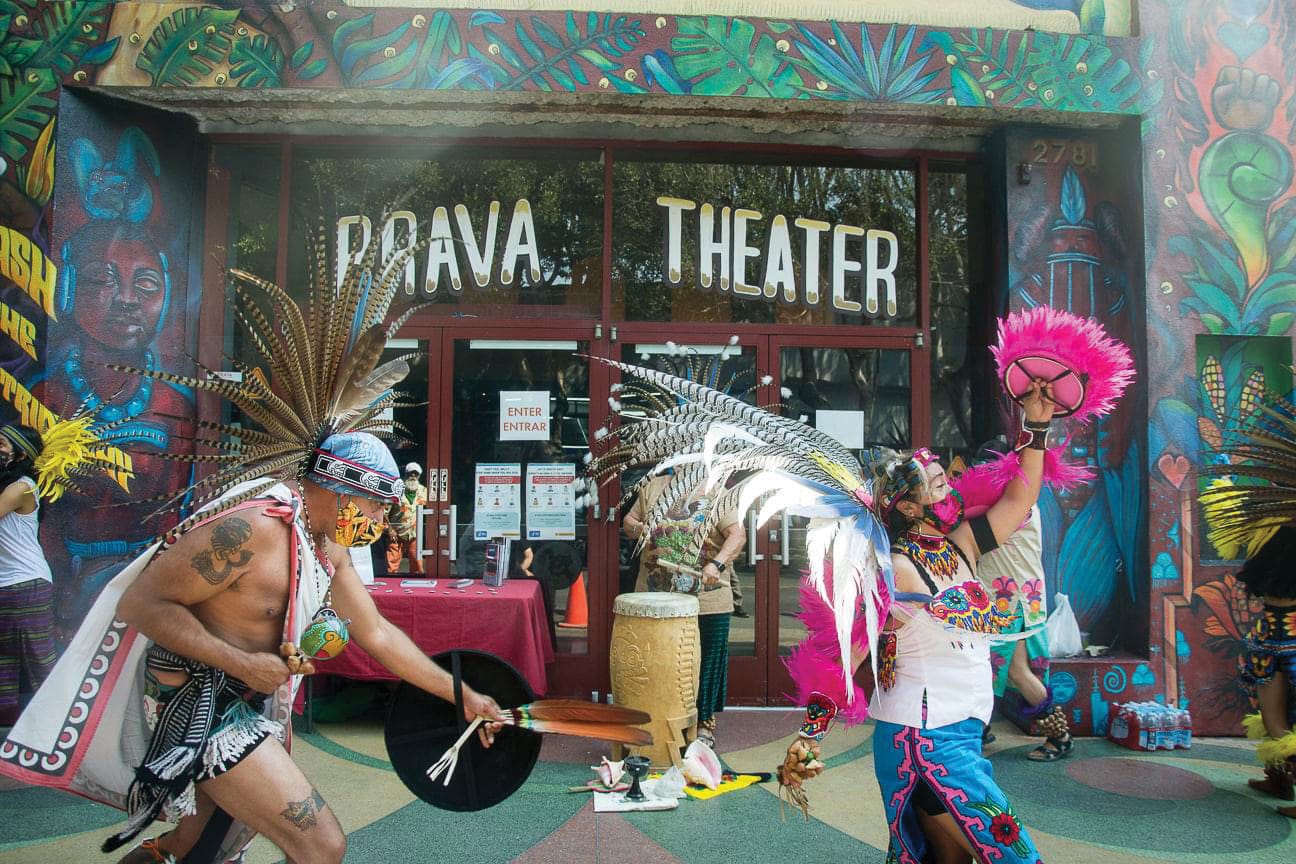
Community Connections
Bringing Music to All San Francisco
The All San Francisco Concert, presented in partnership with the San Francisco Arts Commission, is a dedicated performance for Bay Area nonprofit, social services, and community organizations, in recognition and gratitude for the work these groups do for the citizens of our city. Created in 1980 by veteran philanthropist and San Francisco Symphony Life Governor Ellen Magnin Newman and led by an advisory committee of local nonprofit and community leaders, the concert is a pillar of the Symphony’s community programs. For more information and an All San Francisco Committee list, turn to page SFS6.
The Ellen Magnin Newman Award is presented annually to a Bay Area community-based organization that strengthens our region’s cultural fabric and serves families and individuals to create a more just and equitable society for everyone who lives here. Recipients of the award are celebrated at the All San Francisco Concert and receive a Symphony concert series subscription as well as a cash grant.
This year, the All San Francisco Committee is proud to honor Brava! for Women in the Arts. Brava! for Women in the Arts celebrates nearly 40 years as a professional arts organization dedicated to cultivating the artistic expression of women, 2SLGBTQIA+, people of color, youth, and other underrepresented voices. Learn more about Brava! for Women in the Arts at brava.org.
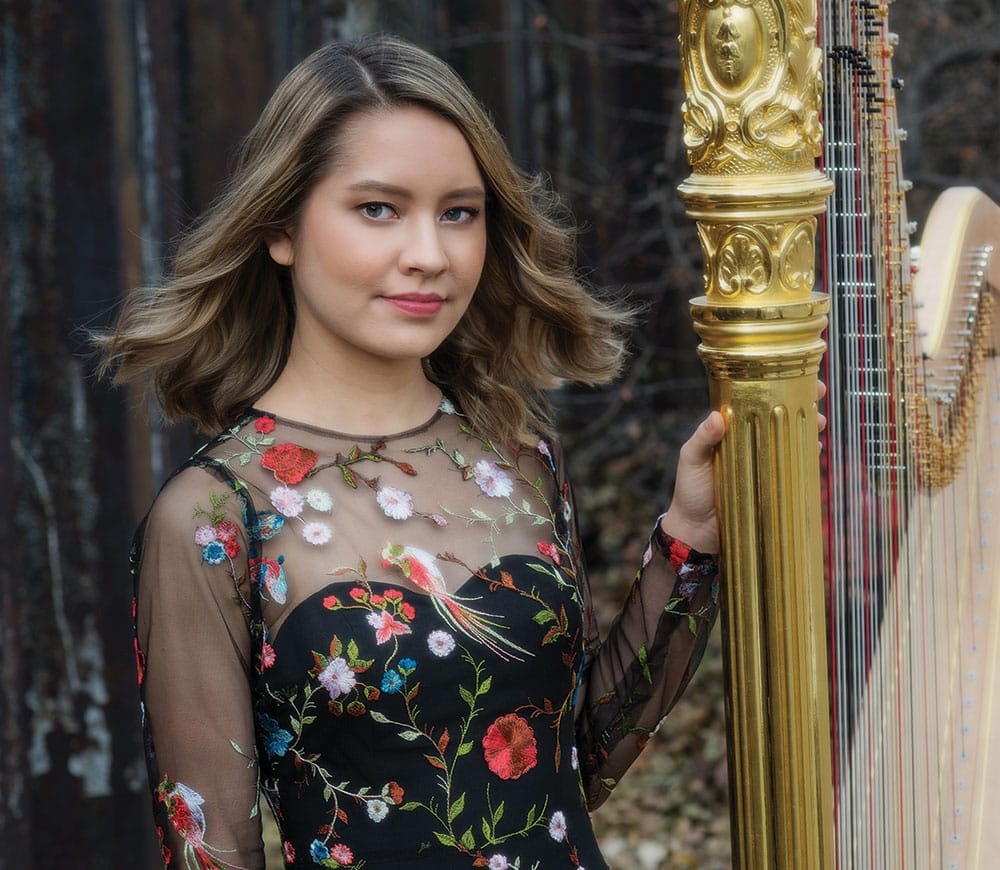
Meet the Musicians
Katherine Siochi, Principal Harp
Katherine Siochi joined the San Francisco Symphony as Principal Harp beginning in the 2023–24 season and was previously principal harp of the Minnesota Orchestra, Kansas City Symphony, and Sarasota Orchestra. She was a gold medalist of the 2016 USA International Harp Competition.
You’ve been a member of the Symphony for about a year now. What was the first concert you played?
My first concert was last year’s Opening Gala. We played Mahler’s Songs of a Wayfarer, which was new to me, but it shares a lot of music with Mahler’s First Symphony. The harp part is even identical in some spots. I really enjoyed that piece.
How did you begin playing the harp?
My first instrument was piano, which I started at about five years old. Then I began studying harp at age 10. It was actually my mom’s suggestion, because she heard about a great harp teacher in Memphis, Tennessee, where we lived at the time. I continued to play both instruments, but chose to focus on harp when I was auditioning for conservatories.
Did you have an especially influential teacher?
At Juilliard, I studied with Nancy Allen, who is principal harp of the New York Philharmonic. She is by far the biggest influence on my playing. She allowed me to become not only a better harpist, but a well-rounded musician. She taught me to think outside of just technique, emphasizing the importance of listening to other instruments and phrasing, which does not come as naturally to the harp.
You’re often the only harpist on stage. But do you closely align with any other group of instruments?
Personally, I think harp is most similar to percussion, because once you play a note, the attack is very precise and the decay is immediate—there’s no way to sustain the sound. And like percussion, the harp stands out by contributing its own unique color and timbre, rather than blending within a larger section.
How would you describe the full breadth of what the harp can do?
We can create many different sounds, not only the angelic, soft, magical, ones. Sometimes when people hear the harp alone, they’re surprised by how loud and powerful it can actually be.
Can you tell us about the specific instruments you play?
Lyon & Healy is the most common harp maker you’ll see in the United States. They’re made in Chicago, and I really love them. The Symphony owns three—those are Salzedo models, which have a geometric Art Deco design. I also own two harps with floral carvings, called Style 23. One of them has goldleaf accents and was actually a prize from a competition.
That’s the harp you’re pictured with here. How did you win it?
It’s from the USA International Harp Competition, which is held every three years at Indiana University in Bloomington. In 2016, I was one of about 40 harpists who competed. Lyon & Healy donates a harp as one of the prizes, in addition to sponsoring a recording. It’s very generous of them.
What’s your preconcert routine?
As harpists, tuning is a big thing for us. There are 47 strings, so I try to be on stage about an hour early to tune when it’s quiet. Then I usually stay on stage to warm up.
What do you enjoy doing outside of music?
I like making elaborate meals and trying to present the food in a beautiful way. I enjoy pretty much every possible type of cuisine. My mom would cook spicy food, and my dad is half Filipino and half Brazilian, so he would always make those cuisines. As a kid growing up, I learned to enjoy a lot of different foods.
Which concerts are you especially looking forward to this season?
I’m very excited for Tchaikovsky’s Swan Lake (March 13–14, 2025), which has incredible harp cadenzas, and also Fountains of Rome and Pines of Rome (May 2–3). The full Firebird ballet (May 23–25) has three harps, which is really special, since we don’t often get more than two! And I also love Howard Shore’s score for The Lord of the Rings: The Two Towers (May 8–10). Those movies are so nostalgic for me.
Print Edition
